
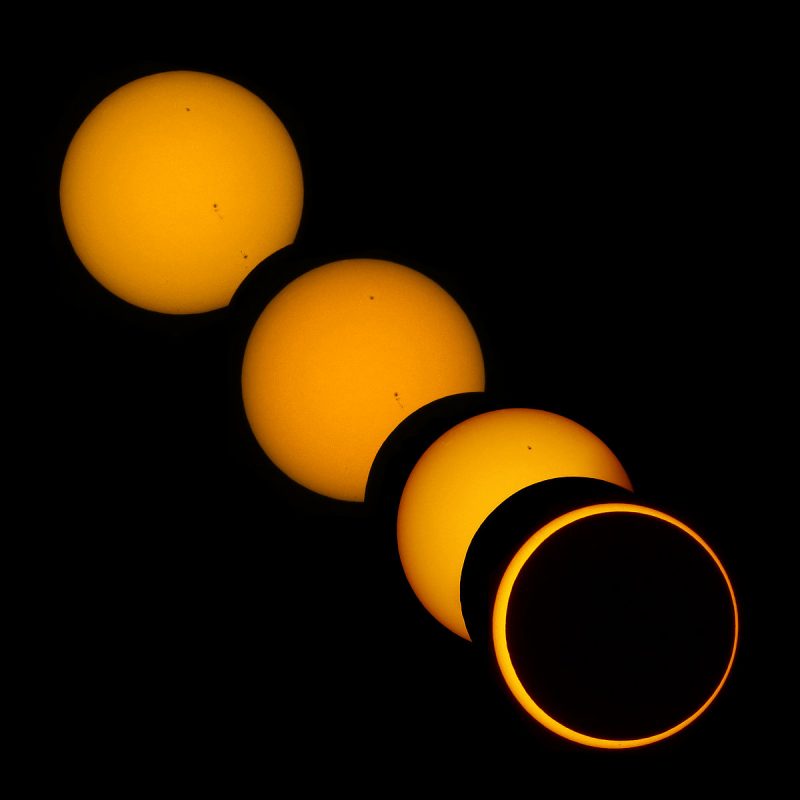
Various stages of an annular solar eclipse from Brocken Inaglory via Wikimedia Commons.
Eclipses of the new moon and full moon don’t occur every month, because the moon’s orbital plane is inclined by about 5 degrees to the plane of the ecliptic (Earth’s orbital plane). But the moon’s orbital path does intersect the Earth’s orbital plane at two points called nodes. Whenever these lunar nodes point directly at the sun, it marks the midpoint of the eclipse season. The lunar nodes line up with the sun in periods of about 173.3 days, or nearly 10 days shy of six calendar months.
The middle of the eclipse season (when the line of nodes points directly the sun) last took place on December 30, 2019. The middle of the eclipse season will next occur on June 20, 2020, and then – after that – on December 11, 2020.
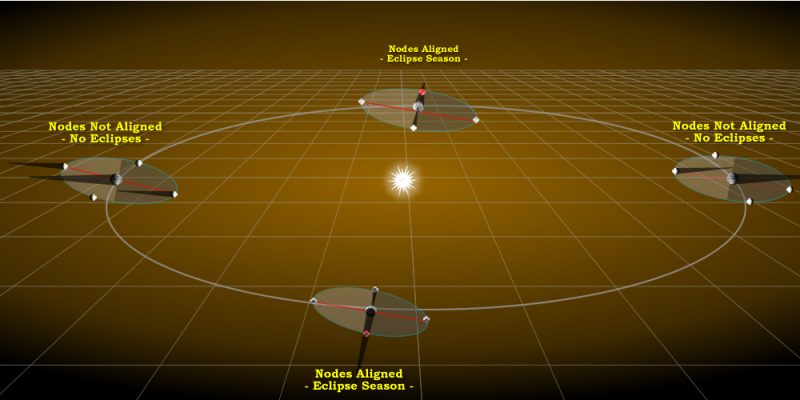
Whenever the lunar nodes point directly at the sun, it marks the midpoint of the approximate 35-day eclipse season. In the year 2020, the middle of the eclipse season occurs on June 20, 2020, and then again on December 11, 2020. Image via Go Science Go.
An eclipse season lasts for approximately 35 days, and any new moon or full moon occurring within this time period will undergo an eclipse. Given that the lunar month (period of time between successive new moons or successive full moons) is about 29.5 days long, a minimum of two eclipses (one solar and one lunar, in either order), or a maximum of three eclipses (either lunar/solar/lunar, or solar/lunar/solar) can take place in one eclipse season.
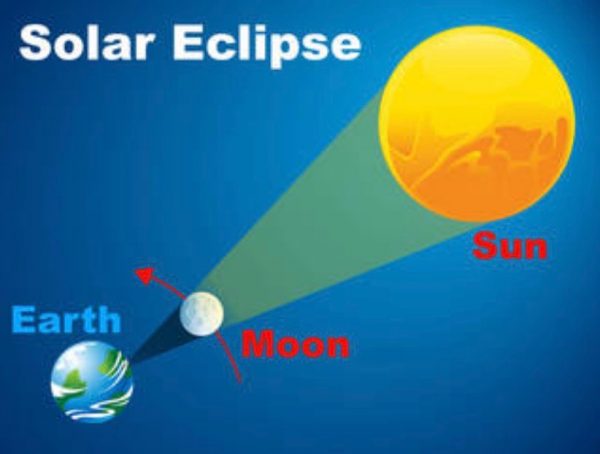
Eclipses are all about alignments. In a solar eclipse, the sun, moon and Earth line up, with the moon in the middle. Image via NASA.

In a lunar eclipse, the sun, Earth and moon line up, with the Earth in the middle. Image via NASA.
Most often, there are only two eclipses in one eclipse season. For three eclipses to occur, the first one has to come quite early in the eclipse season to allow for a third eclipse near the end. For the first time since the year 2018, we’ll have three eclipses in one eclipse season in 2020. We won’t have three eclipses in one eclipse season again until the year 2029.
The year 2020:
June 5, 2020: Penumbral lunar eclipse
June 21, 2020: Annular solar eclipse
July 5, 2020: Penumbral lunar eclipse
Read more: How often are there 3 eclipses in a month?
If an eclipse happens at or near the mid-point of the eclipse season, as the upcoming solar eclipse on June 21st does, then we’ll have a central eclipse. If it’s a solar eclipse, the central eclipse presents either a total or annular eclipse of the sun; or if it’s a lunar eclipse, the central eclipse features a total eclipse of the moon. If the eclipse falls near the beginning or the end of the eclipse season, it’s either a penumbral eclipse of the moon or small partial eclipse of the sun.
Read more: Annular eclipse of the sun on June 21, 2020
Because the lunar eclipses occur so early and so late in the June/July 2020 eclipse season, the lunar eclipses on June 5, 2020, and July 5, 2020, will be extremely faint and hard-to-see penumbral lunar eclipses. See the illustration of these eclipses below.
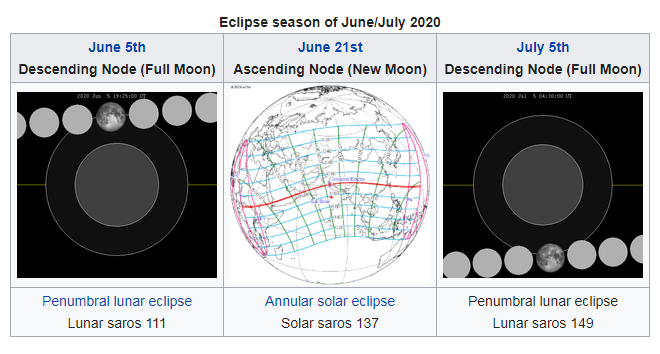
The next eclipse season in June/July 2020 will showcase three eclipses (lunar/solar/lunar). Image via Wikipedia.
On the other hand, the solar eclipse on June 21, 2020, which takes place almost dead center in the eclipse season, will present a central eclipse, exhibiting an annular eclipse of the sun. See diagram above.
Thirty-eight eclipse seasons (19 eclipse years) are almost exactly commensurate to 223 lunar months, a period of 18 years and 11 1/3 days (four intervening leap years) or 18 years and 10 1/3 days (5 intervening leap years). Therefore, the eclipses coming up in June/July 2038 display similar geometries to those in June/July 2020. This 223-lunar-month period of time is known as the Saros.
The year 2020:
June 5, 2020: Penumbral lunar eclipse
June 21, 2020: Annular solar eclipse
July 5, 2020: Penumbral lunar eclipseThe year 2038:
June 17, 2038: Penumbral lunar eclipse
July 2, 2038: Annular solar eclipse
July 16, 2038: Penumbral lunar eclipse
Interestingly, the Sar or Half Saros, representing a period of 111.5 lunar months (9 years and 5 2/3 days), gives us alternating eclipses (solar/lunar/solar) of similar character. Contrast the years 2020 and 2038 listed above with the years 2029 and 2047 listed below.
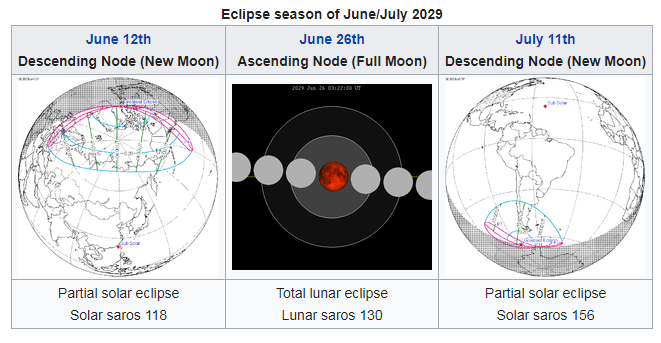
Many people are familiar with the Saros period of 223 lunar months (18.03 years), whereby a similar progression of eclipses takes place in one eclipse season (lunar/solar/lunar). Less well known, the Sar or Half Saros of 111.5 lunar months (9.015 years) also presents 3 eclipses in one eclipse season, though in alternate order (solar/lunar/solar). Image via Wikipedia.
The year 2029:
June 12, 2029: Partial solar eclipse
June 26, 2029: Total lunar eclipse
July 11, 2029; Partial solar eclipseThe year 2047:
June 23, 2047: Partial solar eclipse
July 7, 2047: Total lunar eclipse
July 22, 2047: Partial solar eclipse
The eclipse master Fred Espenak tells us a Saros series can last anywhere from 1,226 to 1,550 years and is made up of 69 to 87 eclipses. A Saros series, whether it be solar or lunar, always starts off with skimpy eclipses and ends with skimpy eclipses. The middle of a Saros series brings about the closest alignment of the three celestial bodies – Earth, sun and moon – whereby they line up almost perfectly in space.
In any eclipse season where there are three eclipses, the first and third eclipses are meager productions whereas the middle eclipse is a highly visible central eclipse. And in any Saros series, the early and late eclipses are also paltry at best, whereas the middle part of a Saros series presents central eclipses.
Here’s something that may surprise you: Any eclipse happening early in an eclipse season always occurs late in a Saros series – and vice versa. For example, let’s look at the upcoming three-eclipse season in June/July 2020:
The year 2020:
June 5, 2020: Penumbral lunar eclipse
June 21, 2020: Annular solar eclipse
July 5, 2020: Penumbral lunar eclipse
The first eclipse of the eclipse season on June 5, 2020, belongs to Lunar Saros 111 and presents the 67th of 71 eclipses in this Saros series. Yet, the third and final eclipse of the eclipse season on July 5, 2020, belongs to Lunar Saros 149, and features the third of 71 eclipses in this particular Saros series.
Unsurprisingly, perhaps, the second (or middle) eclipse of the eclipse season on June 21, 2020, is the 36th of 70 eclipses in Solar Saros 137.
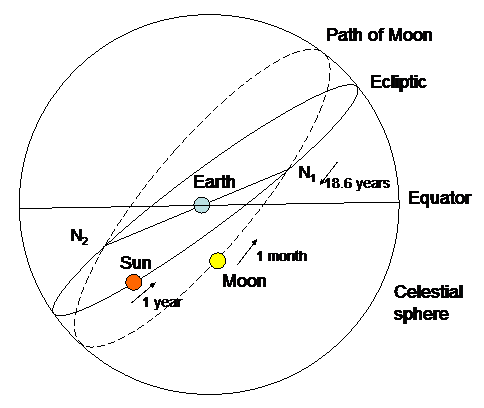
The plane of the moon’s orbit is inclined at 5 degrees to the plane of Earth’s orbit around the sun (the ecliptic). In this diagram, however, the ecliptic is portrayed as the sun’s apparent annual path in front of the constellations of the zodiac. The moon’s orbit intersects the ecliptic at two points called nodes (labeled here as N1 and N2). It’s the middle of the eclipse season whenever this line of nodes points directly at the sun. In the above diagram, the line of nodes does not point at the sun.
Bottom line: The middle of the eclipse season falls on June 20, 2020, and this eclipse season produces three eclipses (lunar/solar/lunar), though only the second of these three eclipses – the annular “ring of fire” eclipse on June 21, 2020 – will produce any real theatrics on the great stage of the sky.
from EarthSky https://ift.tt/2UkWFi1


Various stages of an annular solar eclipse from Brocken Inaglory via Wikimedia Commons.
Eclipses of the new moon and full moon don’t occur every month, because the moon’s orbital plane is inclined by about 5 degrees to the plane of the ecliptic (Earth’s orbital plane). But the moon’s orbital path does intersect the Earth’s orbital plane at two points called nodes. Whenever these lunar nodes point directly at the sun, it marks the midpoint of the eclipse season. The lunar nodes line up with the sun in periods of about 173.3 days, or nearly 10 days shy of six calendar months.
The middle of the eclipse season (when the line of nodes points directly the sun) last took place on December 30, 2019. The middle of the eclipse season will next occur on June 20, 2020, and then – after that – on December 11, 2020.

Whenever the lunar nodes point directly at the sun, it marks the midpoint of the approximate 35-day eclipse season. In the year 2020, the middle of the eclipse season occurs on June 20, 2020, and then again on December 11, 2020. Image via Go Science Go.
An eclipse season lasts for approximately 35 days, and any new moon or full moon occurring within this time period will undergo an eclipse. Given that the lunar month (period of time between successive new moons or successive full moons) is about 29.5 days long, a minimum of two eclipses (one solar and one lunar, in either order), or a maximum of three eclipses (either lunar/solar/lunar, or solar/lunar/solar) can take place in one eclipse season.

Eclipses are all about alignments. In a solar eclipse, the sun, moon and Earth line up, with the moon in the middle. Image via NASA.

In a lunar eclipse, the sun, Earth and moon line up, with the Earth in the middle. Image via NASA.
Most often, there are only two eclipses in one eclipse season. For three eclipses to occur, the first one has to come quite early in the eclipse season to allow for a third eclipse near the end. For the first time since the year 2018, we’ll have three eclipses in one eclipse season in 2020. We won’t have three eclipses in one eclipse season again until the year 2029.
The year 2020:
June 5, 2020: Penumbral lunar eclipse
June 21, 2020: Annular solar eclipse
July 5, 2020: Penumbral lunar eclipse
Read more: How often are there 3 eclipses in a month?
If an eclipse happens at or near the mid-point of the eclipse season, as the upcoming solar eclipse on June 21st does, then we’ll have a central eclipse. If it’s a solar eclipse, the central eclipse presents either a total or annular eclipse of the sun; or if it’s a lunar eclipse, the central eclipse features a total eclipse of the moon. If the eclipse falls near the beginning or the end of the eclipse season, it’s either a penumbral eclipse of the moon or small partial eclipse of the sun.
Read more: Annular eclipse of the sun on June 21, 2020
Because the lunar eclipses occur so early and so late in the June/July 2020 eclipse season, the lunar eclipses on June 5, 2020, and July 5, 2020, will be extremely faint and hard-to-see penumbral lunar eclipses. See the illustration of these eclipses below.

The next eclipse season in June/July 2020 will showcase three eclipses (lunar/solar/lunar). Image via Wikipedia.
On the other hand, the solar eclipse on June 21, 2020, which takes place almost dead center in the eclipse season, will present a central eclipse, exhibiting an annular eclipse of the sun. See diagram above.
Thirty-eight eclipse seasons (19 eclipse years) are almost exactly commensurate to 223 lunar months, a period of 18 years and 11 1/3 days (four intervening leap years) or 18 years and 10 1/3 days (5 intervening leap years). Therefore, the eclipses coming up in June/July 2038 display similar geometries to those in June/July 2020. This 223-lunar-month period of time is known as the Saros.
The year 2020:
June 5, 2020: Penumbral lunar eclipse
June 21, 2020: Annular solar eclipse
July 5, 2020: Penumbral lunar eclipseThe year 2038:
June 17, 2038: Penumbral lunar eclipse
July 2, 2038: Annular solar eclipse
July 16, 2038: Penumbral lunar eclipse
Interestingly, the Sar or Half Saros, representing a period of 111.5 lunar months (9 years and 5 2/3 days), gives us alternating eclipses (solar/lunar/solar) of similar character. Contrast the years 2020 and 2038 listed above with the years 2029 and 2047 listed below.

Many people are familiar with the Saros period of 223 lunar months (18.03 years), whereby a similar progression of eclipses takes place in one eclipse season (lunar/solar/lunar). Less well known, the Sar or Half Saros of 111.5 lunar months (9.015 years) also presents 3 eclipses in one eclipse season, though in alternate order (solar/lunar/solar). Image via Wikipedia.
The year 2029:
June 12, 2029: Partial solar eclipse
June 26, 2029: Total lunar eclipse
July 11, 2029; Partial solar eclipseThe year 2047:
June 23, 2047: Partial solar eclipse
July 7, 2047: Total lunar eclipse
July 22, 2047: Partial solar eclipse
The eclipse master Fred Espenak tells us a Saros series can last anywhere from 1,226 to 1,550 years and is made up of 69 to 87 eclipses. A Saros series, whether it be solar or lunar, always starts off with skimpy eclipses and ends with skimpy eclipses. The middle of a Saros series brings about the closest alignment of the three celestial bodies – Earth, sun and moon – whereby they line up almost perfectly in space.
In any eclipse season where there are three eclipses, the first and third eclipses are meager productions whereas the middle eclipse is a highly visible central eclipse. And in any Saros series, the early and late eclipses are also paltry at best, whereas the middle part of a Saros series presents central eclipses.
Here’s something that may surprise you: Any eclipse happening early in an eclipse season always occurs late in a Saros series – and vice versa. For example, let’s look at the upcoming three-eclipse season in June/July 2020:
The year 2020:
June 5, 2020: Penumbral lunar eclipse
June 21, 2020: Annular solar eclipse
July 5, 2020: Penumbral lunar eclipse
The first eclipse of the eclipse season on June 5, 2020, belongs to Lunar Saros 111 and presents the 67th of 71 eclipses in this Saros series. Yet, the third and final eclipse of the eclipse season on July 5, 2020, belongs to Lunar Saros 149, and features the third of 71 eclipses in this particular Saros series.
Unsurprisingly, perhaps, the second (or middle) eclipse of the eclipse season on June 21, 2020, is the 36th of 70 eclipses in Solar Saros 137.

The plane of the moon’s orbit is inclined at 5 degrees to the plane of Earth’s orbit around the sun (the ecliptic). In this diagram, however, the ecliptic is portrayed as the sun’s apparent annual path in front of the constellations of the zodiac. The moon’s orbit intersects the ecliptic at two points called nodes (labeled here as N1 and N2). It’s the middle of the eclipse season whenever this line of nodes points directly at the sun. In the above diagram, the line of nodes does not point at the sun.
Bottom line: The middle of the eclipse season falls on June 20, 2020, and this eclipse season produces three eclipses (lunar/solar/lunar), though only the second of these three eclipses – the annular “ring of fire” eclipse on June 21, 2020 – will produce any real theatrics on the great stage of the sky.
from EarthSky https://ift.tt/2UkWFi1

Aucun commentaire:
Enregistrer un commentaire